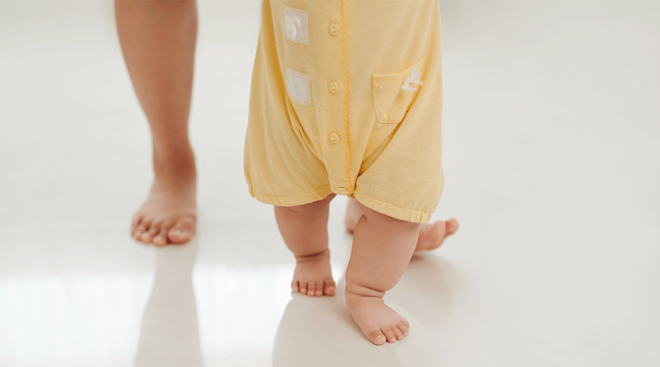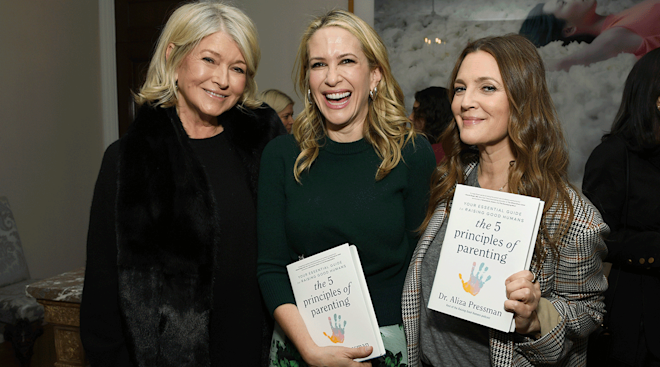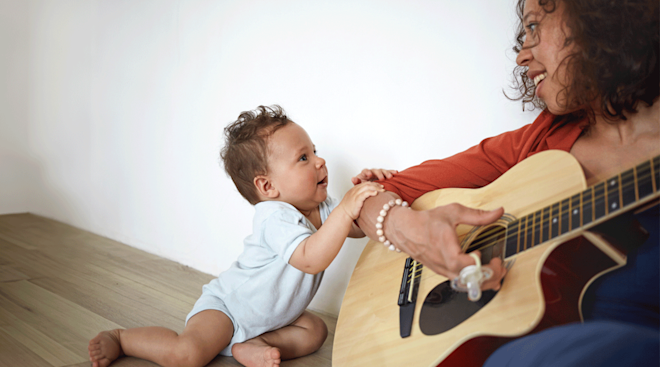How to Raise a Happy Baby
From the moment we first see their slimy (but totally adorable) little heads, we want the best for our babies—and that includes their happiness. The truth is, we can influence just how happy they are, both now and in the future. Here’s what you need to do.
Respond to Baby’s Cries
Sounds obvious, right? The trick is to create a pattern so baby knows you’re predictable and reliable. This doesn’t mean you have to jump up every time baby makes a peep—there are going to be times when she cries and cries and cries, or when she soothes herself—but it does mean attending to her needs more than the majority of the time.
“Babies go through these tsunamis of emotion,” says Harvey Karp, MD, professor of pediatrics at the USC School of Medicine and author of The Happiest Baby on the Block and The Happiest Toddler on the Block. “For babies, it’s contentedness, serenity and security that make them happy. Twenty times a day, something upsets them and then magically, arms pick them up and they’re fed, or someone comes and rocks them.” (We can relate. It sounds a little like PMS.)
“Babies quickly learn, ‘I like this place and these people. I trust them. People take care of me,’” says Karp. “You’re building a sense of confidence in baby that things will work out. There’s optimism in predictability for them.” And that can pay off for life.
“It becomes the basis for the other relationships they’ll have—they’ll build on that intimacy from the first nine months of their life,” he says. “It’s not to say a child can’t have a happy life if they didn’t have that. It would just be a whole lot harder.”
Learn How to Swaddle
Invest in some easy-to-wrap swaddling blankets—you’re going to need them. That’s because, for most babies, being wrapped up snugly is comfy, reminding them of their time in utero, and triggers what Karp calls “the calming reflex.”
“For at least the first four months, all babies need to be swaddled,” he says. “For some, that’s all they need. Others will need [some other soothing method too]. If they’re colicky, they may need three or four or five at the same time to trigger the calming reflex.” (They don’t call moms multitaskers for nothing!) Other soothing methods include shushing sounds, swinging and sucking.
Invest in a White Noise Machine
To create that shushing sound, you’ll want some sort of “white noise” maker. Which is best? Karp says high-pitched noises (think: vacuum cleaner, blow-dryer) can calm a crying baby, while more lower-pitched, rumbling sounds (lawn mower, car engine) mimic what babies hear in utero and can be used to calm them down to sleep. Just be careful not to use something so loud it could harm baby’s hearing.
Embrace the Pacifier or Thumb-Sucking
Karp says sucking also triggers the calming reflex. So as much as you’re tempted to have a life without cleaning binkies or to pull baby’s thumb out of his mouth, let it go for now—it makes him happy. You can worry about giving it up later.
Develop a Ton of Patience
Around eight or nine months, you might look around and realize baby is a completely different person than she was a few months ago. She’s on her way to toddlerhood. “At 8 or 9 months old, they will rub or pat your knee when you’re crying. They understand that people have emotions and understand that emotional connection,” says Karp.
Of course, this is also the time when tantrums start. Karp explains that adults use the left side of their brain to control their emotions, but toddlers’ left brains aren’t developed enough to do that just yet. Instead, they’re liable to scream, throw things, hit, spit or scratch—or (if you’re really lucky) all of the above.
In order to keep public embarrassment to a minimum—and to teach your toddler better communication skills and emotional regulation—it’s important to not give in to her demands when she has a tantrum. Sure, giving her that cookie would get her to stop screaming, but then she’ll just learn that screaming gets her what she wants, and she’ll keep doing it.
Grow a Longer Temper
Another no-no? Flipping out yourself. You want to set a good example for how people communicate and behave. This may actually take a bit (or if you’re like us, a lot!) of work on your own communication and emotional regulation skills. Find ways to talk to your tantruming child that don’t patronize him or make light of his feelings, but rather acknowledge them. And explain to him once he’s calmed down why he can’t have his way right at that moment. Read on for strategies on how to do it.
Abide by the Fast-Food Rule
Okay, so your toddler is completely wigging out, and you’ve resisted the urge to flip out right back (good for you!). Now what? “Use the fast-food rule,” says Karp. “It’s a way of acknowledging their feelings. Whoever’s hungriest for attention goes first.” In other words, before you say anything, suck up your embarrassment and let her have her tantrum—you’re probably not going to get her to calm down right away. Karp explains that telling your child to calm down right off the bat sends her the message that having feelings isn’t okay.
Acknowledge Your Toddler’s Feelings
Resist the urge to lecture your toddler for 20 minutes about why he shouldn’t have a cookie before dinner because it will spoil his dinner, which you spent an hour making and which no one appreciates but you keep doing it day after day after day…(okay can you tell we’ve been here?) and instead, acknowledge what he’s feeling and say it back to him.
Speak Your Toddler’s Language
This is where what Karp calls “toddlerese” comes in. During an outburst, speak to your child in simple terms she’ll understand—use one- to two-word phrases the way she would, repetition and all.
Karp demonstrates: “‘You really want a cookie. You love cookies. You say cookie now! Cookie now!’ Then once she calms down a bit say, ‘No, no cookies. You’re not allowed to have cookies before dinner.’”
“Say it with emotion in your voice,” he adds. “That makes them feel like you get it. Reflect about one-third of their emotion. People often make the big mistake of speaking in a calmer voice.” But stay away from the sarcastic, angry mom voice—we know it’s there; we have it too! Kids this young really respond to the tone of your voice, perhaps more so than your actual words. Showing your child that you understand the emotions she’s experiencing is likely to prevent the situation from escalating into in an even more blown-out tantrum.
It may seem a little weird to talk this way at first, but give it some practice, and you just might find it works to calm your toddler down when she’s in the thick of a tantrum. Once your child is calm, you can start into your explanation for why she can’t do whatever it is she wanted to do that started the commotion.
The idea is that you won’t be speaking to her this way when she’s 16 (though you might be tempted), and this tactic won’t last forever. You’re giving your child better skills to cope with her emotions and to handle them, rather than letting them take over and explode all the time.
“They learn to acknowledge other people’s feelings when they’re upset,” says Karp. “They’ll do it with you. And they’ll do it later with their friends. They learn to be better friends and better husbands and wives later in life. They learn to deal with people when they’re upset.”
Now go forth and shush, swaddle and toddlerese baby into a happy childhood!
Please note: The Bump and the materials and information it contains are not intended to, and do not constitute, medical or other health advice or diagnosis and should not be used as such. You should always consult with a qualified physician or health professional about your specific circumstances.
Plus, more from The Bump:
Navigate forward to interact with the calendar and select a date. Press the question mark key to get the keyboard shortcuts for changing dates.




















































